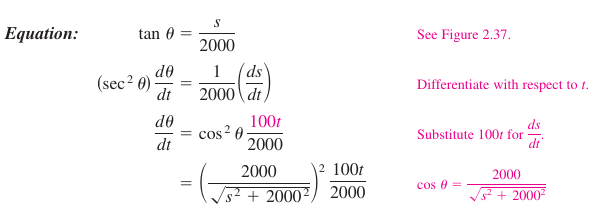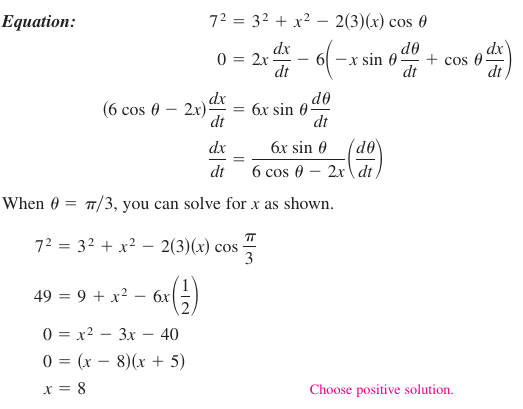Calculus I 02.06 Related Rates
| Previous | Calculus I 02.05 Implicit Differentiation |
| Next | Calculus I 03 Differentiation Applications |
Contents
2.6 Related Rates
|
|
Finding Related RatesThe Chain Rule is used to find the change rates between two or more related variables that are change with respect to time. For example, when water is drained from a conical tank, as shown in Figure 2.6.1, the volume \(V\), the radius \(r\), and the height \(h\) for the water level are all functions in time \(t\). These variables are related by the equation
differentiate implicitly with respect to \(t\) to produce the related-rate equation
This demonstrates the change rate for \(V\) is related to the change rates for both \(h\) and \(r\). |
Example 2.6.1 Two Related Rates
The variables \(x\) and \(y\) are both differentiable functions for \(t\) and are related by the equation
- \(y=x^2+3.\)
Find \(dy/dt\) when \(x=1\), given that \(dx/dt=2\) when \(x=1\).
Solution Apply the Chain Rule to differentiate both sides with respect to \(t\).
|
\(=x^2+3\) | Original equation |
|
$$=\frac{d}{dt}[x^2+3]$$ |
Differentiate with respect to \(t\). |
|
$$=2x\frac{dx}{dt}$$ |
Chain Rule |
When \(x=1\) and \(dx/dt=2\) the equation solves to
- $$\frac{dy}{dt}=2(1)(2)=4.$$
Problem Solving with Related Rates
In Example 2.6.1 the equation relating the variables and the change rate with respect to \(t\) was given.
| Equation: | \(y=x^2+3\) | |
| Given rate: |
$$\frac{dx}{dt}=2$$ |
when \(x=1\) |
| Find: |
$$\frac{dy}{dt}$$ |
when \(x=1\) |
The following exercises leave creating the mathematical model to the student.
Example 2.6.2 Ripples in a Pond
|
|
A pebble is dropped into a calm pond causing ripples to radiate from the drop point in concentric circles, as shown in Figure 2.6.1. The outer ripple's radius \(r\) is increasing at a constant rate at 1 foot per second. When the radius is 4 feet, at what rate is the total rippled area \(A\) changing?
Proceed as in Example 2.6.1.
When the radius is 4 feet the change rate for the area is \(8 \pi\) square feet per second. |
Guidelines for Solving Related-Rate Problems
| 1. | Identify all given and undetermined quantities. Make a sketch and label the quantities. |
| 2. | Write an equation involving the variables whose change rates either are given or unknown. |
| 3. | Apply the Chain Rule and implicitly differentiate both sides with respect to time \(t\). Only then go onto Step 4 below. |
| 4. | Next, substitute into the resulting equation all known values for the variables and their change rates. Then solve for the required change rate. |
Table 2.6.1 below lists mathematical models for change rates. For example, the change rate in the first example is a car's velocity.
| Table 2.6.1 Change Rates | |||
|---|---|---|---|
| Verbal Statement | Mathematical Model | ||
| A car's velocity after traveling for 1 hour at 50 miles per hour. |
| ||
| Water filling a swimming pool at a 10 cubic meter per hour rate. |
| ||
| A gear is revolving with a 25 revolutions per minute rate. One revolution \(=25 \pi\) rad. |
| ||
| A bacteria colony is increasing at a 2000 per hour rate. |
| ||
Example 2.6.3 An Inflating Balloon
|
|
Air is being pumped into a spherical balloon, as shown in Figure 2.6.3, at a 4.5 cubic foot per minute rate. Find the change rate for the radius when it reaches 2 feet.
To find the change rate for the radius produce an equation that relates the radius \(r\) to the volume \(V\).
Differentiating both sides with respect to \(t\) produces
When \(r=2\), the change rate for the radius is
|
In Example 2.6.3, note that the volume is increasing at a constant rate, but the radius is increasing at a variable rate. When two, or more, rates are related it does not mean they are equal or proportional. In this particular case, the radius is growing more, and more slowly, as \(t\) increases.
Example 2.6.4 An Airplane's Speed as Tracked by Radar
|
|
An airplane is flying on a flight path that will take it directly over a radar tracking station, as shown in Figure 2.6.4. The distance \(s\) is decreasing at a 400 miles per hour rate when \(s=10\) miles. What is the plane's speed?
Find the plane's velocity as shown.
Because the velocity is -500 miles per hour, the speed is 500 miles per hour. This is negative because it represents a distance that is decreasing. |
Example 2.6.5 A Changing Elevation Angle
|
|
Find the change rate in the elevation angle for the TV camera in Figure 2.6.5 at 10 seconds after lift-off.
Use Figure 2.6.5 to relate \(s\) and \(\theta\) by the equation \(\tan \theta=s/2000.\) When \(t=10\) and \(s=5000\), the equation produces
When \(t=10\) , \(\theta\) the change rate is \(2/29\) radians per second. |
Example 2.6.5 A Changing Elevation Angle
|
|
In Figure 2.6.7, a 7-inch connecting rod is fastened to a crank with a 3 inch radius. The crankshaft rotates counterclockwise at a constant 200 revolutions per minute rate. Find the piston's velocity when \(\theta =\pi/3\). Solution Label the distances as shown in Figure 2.6.6. Because a complete revolution corresponds to \(2\pi\) radians, it follows that \(d\theta/dt=200(2\pi)=400 \pi\) radians per minute.
Apply the Law of Cosines, as shown in Figure 2.6.6 to find an equation that relates to \(x\) and \(\theta\). Therefore, when \(x=8\) and \(\theta=\pi/3\), the piston velocity is
|
Internal Links
Parent Article: Calculus I 02 Differentiation








